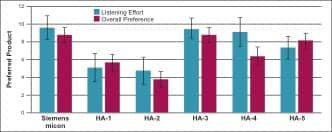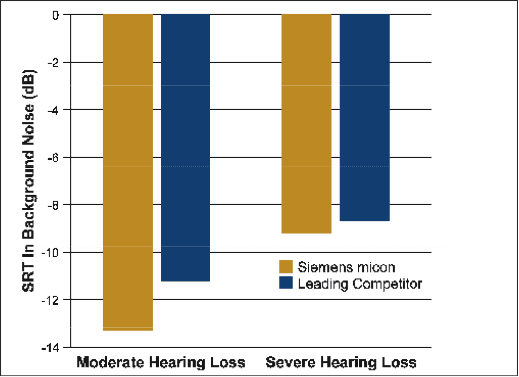By Thomas A. Powers, PhD, and Joel Beilin, MScEE
This article reviews many of the new features of the micon, the latest hearing aid platform from Siemens.
We all recognize the importance of education and training by the hearing care provider for the overall success of hearing instrument fittings. But to a large degree, the selection process is technology driven. That is, the patients usually are searching for “the best” hearing aid. Generally, this means the best technology available—or better than the hearing aids they already have in the case of an experienced user.
Hearing care professionals also seem to be searching for the best hearing aids. Johnson, Mueller, and Ricketts1 reported that the majority of audiologists have a favorite hearing aid manufacturer, and they fit that product to the majority of their patients. These authors report that there are seven major factors that impact the selection of “favorite,” but the leading reason was the company’s technology. Moreover, this factor was the most dominant regardless of what company the audiologists selected as their favorite.
So, if consumers are looking for new technology, and dispensers are looking for new technology, it is important—if not imperative—for manufacturers to introduce new technology on a regular basis. It’s common, therefore, to see one or two “new” products/features every year from all major manufacturers. But is new always better, or just new for the sake of being new? Will the improved features actually make a difference in patient use, benefit, and satisfaction?
This article reviews the new 8th generation digital product from Siemens, the micon. We’ll describe new micon features, and review illustrative supporting research regarding its efficacy and effectiveness. Our contention is that this technology is not just new, but represents a significant step forward in providing high quality amplification.
Core Processing
As discussed in the following sections, new features usually focus on advanced signal processing—often involving directional, noise reduction, and feedback reduction algorithms. We’ll get to those features soon. It’s important, however, not to ignore the fundamental core processing that is responsible for obtaining appropriate audibility for different input levels and optimizing the sound quality for amplified speech. Over the years, Siemens products have pioneered the use of multiple channels of AGCi and AGCo, as well as innovative compression strategies. Fitting algorithms have been designed to provide the optimum balance between audibility, sound quality, and user acceptance.
New developments. With micon, the goal was to expand on many of the fundamental and successful processing strategies. The following is a brief review of some of the refinements:
- Expanded gain and output processing preciseness and adjustment flexibility with 48 channels of AGCi and AGCo compression, controlled using up to 20 handles.
- Unique compression system with several level meters that operate sequentially, resulting in gain and compression time-constants based on the fluctuations detected in the soundscape.
- Extended bandwidth to 12,000 Hz.
All this is accomplished with a new platform, which allows for 18 million transistors, executing 250 million instructions per second. To put this in perspective, this is more than double the processing power of the 7th generation product introduced in 2010, which had 8 million transistors, executing 100 million instructions per second.
Supporting research. In order to systematically evaluate the processing capability and sound quality of the new micon, a comparative study focused on preference ratings was conducted at an independent site, the DELTA SenseLab in Hørsholm, Denmark. The premier hearing aid of the five other major manufacturers was compared to the Siemens micon. All devices were fitted for a mild-to-moderate hearing loss (IEC-N3 audiogram; 35 dB in lows sloping to 65 dB in the highs), with an additional “music program” added. Recordings were made from each instrument, and quality was judged by hearing-impaired listeners from the SenseLab IEC-N3 hearing-impaired panel. The hearing aids were rated on a bi-polar “like-least” to “like-most” scale, using a MUSHRA methodology. Both listening effort and quality ratings were conducted for several conditions including speech in quiet, in noise, in several environmental background scenarios, and also for music. At the conclusion, ratings were averaged among conditions to obtain an overall preference rating.
|
|
|
Figure 1. Preference ratings for the Siemens micon compared to five other premier instruments from other leading manufacturers. Preference ratings obtained using MUSHRA methodology; displayed for listening effort and overall preference. |
Figure 1 shows the preference ratings for the six hearing aids for both listening effort and overall preference. Recall that the five competitive instruments were the premier model from the other major manufacturers, so large differences in the ratings were not expected. For listening effort, the micon rated highest, along with HA-3 and HA-4. When the overall preference was calculated, again micon rated highest, along with HA-3. HA-1 and HA-2 rated significantly lower for both comparisons. The results regarding this perceived global sound quality indicate a high overall performance for the micon.
Directional Technology and Digital Noise Reduction
Surveys continually reveal that, despite technology advances, many hearing aid users continue to be dissatisfied with their ability to understand speech in background noise. While wireless solutions have solved some of these problems, we continue to depend on directional technology and digital noise reduction for most challenging listening situations.
Directional technology in hearing aids has been available since the late 1960s, but with today’s digital instruments, the adaptability and effectiveness for specific listening situations have increased substantially. Research with Siemens digital directional products has been especially encouraging. In early digital hearing aid research, Ricketts and Dhar2 reported a directional benefit for word recognition in noise of nearly 5 dB, even in a moderately reverberant room. In 2004, Bentler, Palmer, and Dittberner3 reported that hearing-impaired individuals, fitted with directional amplification, performed equal to young normal-hearing participants in the Hearing in Noise Test (HINT). When Siemens adaptive directional technology was introduced, Ricketts, Hornsby and Johnson4 found a 7.5 dB advantage for the adaptive algorithm when there was a moving noise source in a reverberant listening environment.
Most recently, Mueller, Weber, and Bellanova5 evaluated a new Siemens directional algorithm, called SpeechFocus, which enhances speech communication in noise when speech is from the back or the sides. When speech was presented from behind the listeners with background noise present, the authors report a ~5 dB advantage when compared to omnidirectional, and a ~10 dB advantage when compared to traditional automatic/adaptive directional.
Siemens also has been a leader in digital noise reduction. As early as 1999, Ricketts and Dhar2 showed a 2 dB advantage for speech recognition in background noise (HINT) for the modulation-based DNR of the Siemens Prisma. In later years, Wiener filter technology was added to enhance the DNR processing. Ricketts and Hornsby6 reported that, when this filtering was combined with the modulation-based DNR, hearing-impaired listeners had a strong preference for DNR-On versus DNR-Off for several listening conditions.
A third type of DNR, working independently to the other two systems, was introduced in 2006. This was a transient noise reduction algorithm dubbed “SoundSmoothing.” In recent research, DiGiovanni, Davlin, and Nagaraja7 reported that, when this transient noise algorithm was activated, significant improvement in speech recognition in a multi-talker background was present for a group of hearing-impaired listeners. While DNR has long been recognized for improving listener comfort and ease of listening, this is one of the first research findings (published in a scientific journal) to show significant improvement for speech recognition in background noise for this feature.
New developments. As reviewed above, both directional technology and DNR have proven to be successful in improving speech understanding in background noise. What has been lacking, however, is the sharing of knowledge between these two features.
When the signal classification system detects a speech-in-noise listening situation, DNR is activated. This algorithm is applied to the incoming speech signal equally for sounds originating from all azimuths. Because there is speech present, the aggressiveness of the DNR must be tempered; otherwise there would be the risk of reducing important speech sounds while reducing the noise in the “speech gaps.” However, utilizing information from the directional microphone algorithm can determine if the speech is originating from in front or behind the listener. If the target speech is from the front, which is usually the case, then we would assume that speech identified by the anti-cardioid algorithm is noise (or unwanted multitalker speech). Once we have identified the azimuth of the source, it is then possible to apply more aggressive noise reduction to this portion of the incoming signal, which then enhances the overall effectiveness of the DNR.
More specifically, two important types of noise reduction algorithms, previously implemented in Siemens hearing instruments, are based on “modulation analysis,” meaning that the temporal spectrum of the signal envelope is used for deciding which parts of the signal shall be regarded as noise (and attenuated) and which parts belong to the target signal and shall be kept or even enhanced.
What was missing until now was a method to reduce interfering signals with speech-like modulation properties. The solution for this dilemma is to change the criterion, which separates a signal into the target and noise part. Therefore, instead of using modulation properties, the criterion used in the new micon Directional Speech Enhancement has been changed to direction of arrival. The required information about the direction of incidence of the signals can be obtained directly from the beamformer. Thus, the beamforming stage has become an integrated part of the noise reduction system.
Supporting research. To date, clinical studies on the effectiveness of the micon Directional Speech Enhancement have been conducted at two sites. The first study conducted in Hörzentrum, Oldenburg, Germany, used two groups of hearing-impaired subjects: one group with moderate downward sloping hearing loss, and a second group who had severe losses. The speech signal used with competing background noise was the olsa (Oldenburg Sentence Test). In this research, the Siemens micon was compared to the performance of the premier hearing aid of a leading competitor. Both products had noise reduction and directional microphone technology activated (for the micon, this included the new Directional Speech Enhancement algorithm).
|
|
|
Figure 2. Group mean results for the Siemens micon compared to a leading competitor for a speech recognition in noise test (olsa). Results are shown for two different hearing loss groups. Lower scores indicate better performance. |
Figure 2 displays the olsa test results for both hearing aids and both hearing loss groups. The bars on the chart represent the 50% correct point for the sentences in background noise; hence negative numbers are better (down on the chart). Observe that for the moderate hearing loss group, the scores for both instruments were quite good; however, there was a noticeable 2 dB advantage for the micon. The micon advantage also was present for the severe hearing loss group, although to a lesser degree.
A second study examining the Directional Speech Enhancement algorithm of micon was conducted at the University of Iowa. Again, the micon was compared to the premier product of a different manufacturer; this was not the same manufacturer used for the Oldenburg study, and was particularly selected because this premier product utilizes a spatial noise canceller in conjunction with the beamformer. The speech test stimuli were the HINT sentences, with the International Speech Test Signal (ISTS) used as the background noise. The subjects had mild-to-moderate bilateral downward sloping hearing losses, and were tested for both an omnidirectional setting, and with all directional and noise reduction features activated.
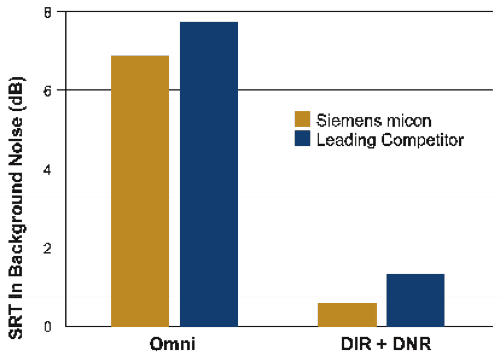
|
| Figure 3. Group mean results for the Siemens micon compared to a leading competitor for the Hearing in Noise Test (HINT). Results shown for both the omni condition, and when directional processing and noise reduction were activated for both instruments. Lower scores indicate better performance. |
The results of the Iowa study are shown in Figure 3. While not a large difference (as expected), this 1 dB advantage can be clinically significant for the understanding of speech. Moreover, and perhaps more importantly, it should be pointed out that the competitive product has battery drain that is nearly double that of the micon.
Automatic Feedback Suppression
Perhaps the most beneficial feature that has been introduced in hearing aids in recent years is automatic feedback cancellation. While on the surface, this feature often does not garner as much acclaim as new beamforming algorithms or unique DNR processing, the indirect benefit is significant. Many patients are now using 10 dB or more gain for soft inputs signals than they would be using if not for the feedback reduction feature. This leads to improved audibility of soft speech, which drives hearing aid benefit.
This is especially critical for open-canal (OC) fittings. Because of these excellent feedback cancelation systems, individuals can now be fitted with open earmolds, minimizing the annoying occlusion effect, a long-standing deterrent for hearing aid use. Moreover, the fact that hearing aids now rarely “whistle” reduces the stigma of wearing hearing aids.
Not all feedback reduction systems, however, are created equal. In 2010, a paper8 presented by Todd Ricketts compared the feedback reduction capabilities of the Siemens Pure product to the premier model of the five other major manufacturers. The comparative measure was maximum insertion gain for an open fitting. All products had maximum insertion gains at either 2000 or 3000 Hz. If we average the gain for 2000 and 3000 Hz, and look at the average for all six manufacturers, it is 26 dB. However, two products averaged only 20 to 22 dB of gain for this frequency region. The Siemens hearing instrument delivered an average of 32 dB of feedback-free gain—6 dB above average and 10 dB more gain than two other products tested (for a complete review see Chalupper et al9).
New developments. Given the success with the previous generation of digital feedback suppression, one might question what improvements are necessary? However, two significant improvements were implemented in micon that significantly enhance feedback stability, while maintaining high speech quality.
The first relates to feedback when directional microphone technology is active. In many hearing aid listening situations, automatic directional is activated by using the signals of two omnidirectional microphones. For such adaptive directional microphone systems, the particular directional characteristic changes with the particular acoustic situation and signal. This means that the feedback path is altered depending on the given directional microphone pattern at a given point in time. The directional pattern is adjusted thousands of times every second, which challenges the feedback cancelation system that is estimating the feedback path. The micon system avoids errors by treating the two omnidirectional microphones as independent input signals before the directional signal is calculated. In this way, the base for the feedback path estimation is always the stable omnidirectional signals. This results in a significantly improved feedback cancellation algorithm.
The second feedback solution relates to what is sometimes thought of (however inappropriately) as the “static feedback path.” For most of the day, the feedback path is relatively stable. However, this path changes considerably when the user hugs a friend or loved one, uses a phone, leans against a wall, or simply reclines on a couch. Critical gain measures obtained at the time of the fitting are important for establishing the baseline for feedback reduction. However, when the feedback path changes, these measures have less relevance to the corresponding acoustic condition. The result may be feedback.
With micon, an automatic “hidden” critical gain estimation has been introduced. We say “hidden,” as it is not initiated by the fitting software and is conducted without any impact on the hearing instrument behavior. No special measurement signal is presented, nor does any calculation interrupt the normal hearing instrument functionality. The system simply updates the information on the current frequency-specific critical gain based on the incoming signal, and adjusts the base from which to apply the feedback detection and phase-cancellation algorithms. This feature assures that the hearing aid will be as feedback-free in these changing acoustic situations as when the feedback path is stable.
Supporting research. To evaluate the real-world effectiveness of the micon feedback reduction algorithm, a large group of hearing-impaired subjects with downward sloping hearing loss (average high frequency loss of 64 dB) were fitted bilaterally. Importantly, each individual was fitted according to prescriptive targets for their hearing loss—that is, gain was not reduced to minimize the possibility of feedback. It is also important to note that the majority of subjects were fitted with open, or nearly-open, domes. At the time of the initial fitting, in 97% of the fittings, no feedback could be provoked after first fit, while sound quality was rated as good or very good in 89% of the fittings. The subjects then used the hearing aids in their everyday listening situations for 2 weeks.

|
| Figure 4. Satisfaction ratings for Siemens micon feedback suppression following use of instruments in everyday listening environments. |
As shown in Figure 4, the real-world satisfaction for the micon feedback reduction was excellent. Overall results show that 92% of the users were satisfied, with the majority being “very satisfied” (very satisfied 63%; satisfied 29%). To put these findings in perspective, the recent MarkeTrak VIII survey10 found that only 17% of hearing aid users were “very satisfied” regarding feedback control, with only 69% satisfied to any degree.
Frequency Lowering
Frequency lowering has been available in wearable hearing aids for the past two decades. By frequency lowering, we mean that the high frequencies contained within the bandwidth of the hearing aid are moved to a lower region. The idea is that these frequencies are not useful and/or continue to be inaudible for some hearing losses if amplified at their source origin. The frequencies that are moved—and where they are moved to—is dependent primarily on the audiometric configuration of the patient. Frequency lowering can be accomplished by using transposition or compression. There is little data to suggest that one of these lowering procedures is superior to the other.
New developments. Primum non nocere is one of the principal tenets of medical ethics; likewise, one of the fundamental goals of implementing frequency lowering for the micon also is to “first do no harm.” By harm, we mean removing amplification from a higher frequency range where it might still be useful, and/or distorting the signal in lower frequencies by adding new information inappropriately. For this reason, the micon frequency lowering feature is implemented based on an algorithm that carefully considers the degree of the high-frequency hearing loss, the prescribed gain for the high-frequency region, the effective audibility for these frequencies, and the probability for cochlear dead regions.
The underlying algorithm is frequency compression, with an adjustable kneepoint, ratio, and target frequency range for the compressed signal. While we recommend using the fitting algorithm for activation and initial settings, the compression settings can be easily altered at the time of the fitting, and frequency compression can be turned on or off depending on patient needs.
Supporting research. Field studies with micon frequency compression are ongoing at this time, but the laboratory data collected during algorithm development were encouraging. In general, the research revealed that patient benefit is related to the highest audible frequency for the patient, which is used to determine the kneepoint of the compression (ie, the hearing must be good enough that the compressed signal is audible). As expected, more benefit is obtained when the highest audible frequency is lower. Our research showed that, when the highest audible frequency was below 4000 Hz, for speech in noise testing, the majority of patients showed an advantage for frequency compression activated, with an average SNR benefit ~1 dB.
Ratings for Everyday Use Listening Conditions
In this article, we have reviewed several laboratory studies focusing on the micon, the majority of which were from research laboratories with controlled settings. It is also important to assess the overall performance for everyday real-world use with all the features activated.
Localization. The first of these studies was conducted at the University of Northern Colorado. In this study, our interest was real-world localization. We focused on this area because one of the overriding objectives in the development of micon was to provide an amplification system so natural that the person would forget that they were wearing hearing aids. A big part of listening in the real world is localization—for those of us with normal hearing, it’s something we take for granted. When localization ability is disrupted, however, it becomes very noticeable. Behind-the-ear (BTE) hearing aids, because of their microphone location, have the potential to make localization even worse. This is why the micon (and other Siemens products) utilizes TruEar (for a review, see Chalupper et al11).
Supporting research. The participants in this study were new hearing aid users with mild-to-severe downward sloping hearing losses. All were fitted bilaterally with micon BTE instruments and used the hearing aids in their everyday environments. At the start of the study, the participants completed the localization questionnaire developed by Noble et al,12 which yielded their unaided handicap. After 2 weeks of hearing aid use, they again completed the questionnaire relative to their aided performance.
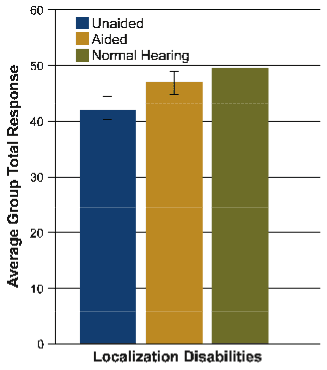
|
| Figure 5. Group mean performance for real-world localization handicap for unaided versus bilateral micon fitting for new hearing aid users. Also shown is performance for young normal-hearing individuals from Ruscetta et al.13 |
As shown in Figure 5, when aided with micon instruments, the average group score improved significantly, indicating a reduction in localization handicap. Perhaps an even more impressive finding is that the aided localization handicap was not significantly different than that obtained for individuals with normal hearing (based on data from Ruscetta et al13 using the same questionnaire). We can assume that, if the localization handicap is no different from people with normal hearing, the overall hearing aid use experience is more “normal.”
In a second study, which assessed listener judgments with all features activated for everyday listening situations, the micon was compared to a leading competitor. The subjects were asked to compare the two different products for both speech understanding and several dimensions related to sound quality. These ratings were obtained shortly after the fitting, and therefore could be viewed as “first impressions.”
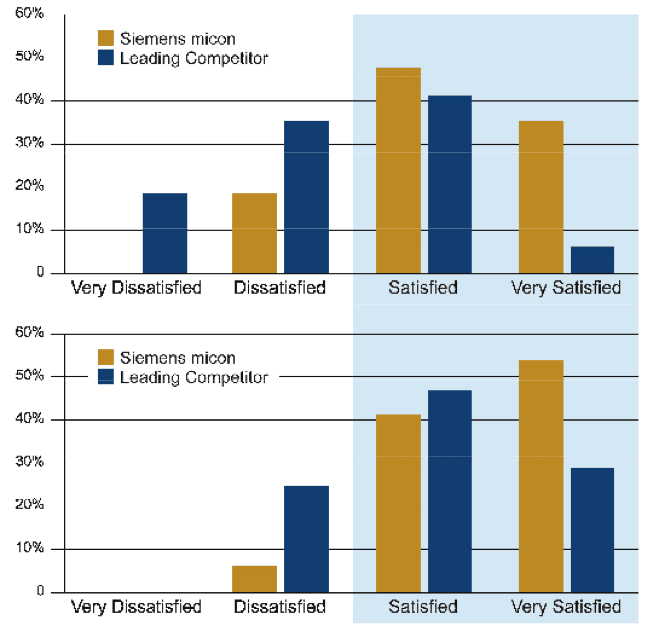
|
| Figure 6. Satisfaction ratings for the Siemens micon compared to a leading competitor. Ratings of quality are displayed in the upper panel; the lower panel reflects judgments of intelligibility. |
Results of this study are shown in Figure 6. The sound quality ratings are shown in the upper panel, and the intelligibility ratings in the lower panel. More than 4 out of 5 (82%) subjects were satisfied with micon, compared to only half (47%) for the competitor. Perhaps more significantly, 53% were dissatisfied with the sound quality of the competing hearing aid. The ratings for intelligibility also significantly favored Siemens micon: 53% were very satisfied, versus only 28% for the competitive model.
Other Special Features
In addition to the major features already discussed, micon offers other features, which for many patients are equally important, and, for some patients, provide the advantage that leads to a successful fitting.
Trainability. Prescriptive fitting methods provide a balance between audibility and listening comfort. The general goal is to place the amplified signals, regardless of the magnitude of their input, at the patient’s preferred listening levels. To do this, average data based on the patient’s pure-tone audiogram are used.
We know, however, that inter-patient variability plays a role in both audibility and listening comfort, even when the hearing losses are the same. To account for this, we need a method to allow the patient to “zero in” on where they fit within the distribution curve. And most important, this needs to be accomplished in the patient’s real-world environment for all types of listening needs. Certainly, the gain needs to be adjusted to optimize speech recognition, but gain also may need to be adjusted for speech in noise, or when noise is the dominant signal. And gain for music also needs to be considered. Some people like their music loud, others like it soft.
It’s this need for the real-world fine-tuning that has made trainable hearing aids so popular. Patient are provided the ability to tell the hearing aids their preferred listening levels; the hearing aid learns and remembers these levels, then applies them when appropriate.
The micon has input-specific and level-specific independent training for six listening situations: quiet, speech in quiet, speech in noise, speech in car noise, noise, and music. Importantly, this training is not conducted in six different programs, but all training occurs independently in the same program—gain and output changes are then steered by the signal classification system. It is not surprising that following 1 to 2 months of training, the majority of patients prefer the trained program to their initial prescriptive fitting.14
Automatic audibility boost. We know that, in general, more audibility leads to improved speech recognition, which leads to greater patient benefit and satisfaction. We also know that, in general, new users prefer less gain than experienced users—this is reflected in our prescriptive fitting algorithms. But when does a new user become an experienced user? After 1 week? One month? Several months? A common fitting goal is to ease the new user into more gain; research had shown that, when the gain is available, many individuals will adapt and re-map their preferred levels.15,16 However, this procedure can be time-consuming for both the dispenser and the patient, as repeat clinic visits often are needed.
The micon has an automated feature that can be used to gradually increase the programmed gain. Using this feature, gain can be increased over weeks or months; the degree of change and time course can be programmed for the specific treatment plan for each patient. The end result is increased audibility (presumably improved speech recognition) while maintaining preferred listening levels.
Tinnitus noiser. A significant number of patients report that they have tinnitus, and approximately 50% of these same patients also report they have a hearing loss. Several treatment options are available to patients with tinnitus, including counseling, the use of tinnitus therapy signals, or therapy signals combined with amplification in a mixed-mode approach.
A set of pre-programmed tinnitus therapy signals (white noise, pink noise, etc) are available with micon, as well as the capability to create frequency-specific therapy signals to match the patients’ tinnitus perception. In specific therapy programs, it is essential that the patient have the ability to control the level of the therapy signal. With micon, in conjunction with the programming software, the patient can have independent control of the hearing aid amplification and the tinnitus therapy signal by setting each volume control (right, left) to control either the amplification or the therapy signal.
In situ testing. Digital hearing aids are capable of producing tones across a wide range of intensities and, hence, can be used to measure audiometric thresholds. This is typically referred to as “in situ testing.” For most applications, the fitting software must be structured so that these digital signals can be compared to traditional audiometric HL values. The fitting software is then configured as an air-conduction audiometer. This feature is available with the new micon product.
The advantage of in situ measures is that it establishes a direct relationship between the ear-canal


|
|
| Thomas A. Powers, PhD, is the vice president of product management at Siemens Hearing Instruments in Piscataway, NJ, and Joel Beilin, MScEE, is global head of audiology relations, Siemens Hearing Solutions, Singapore. |
acoustics used for hearing testing and the delivery of the amplified signal. For example, if with the earmold in place, the volume of the ear canal is unusually small, this will be reflected in the audiometric data—which means it also will be reflected in the applied gain. In situ testing also can be used to alter gain based on measured vent effects. Additionally, in situations where standard audiometry simply isn’t possible, in situ thresholds can be used for programming the instruments.
Wireless Features
Processing. Many of the features discussed above rely on wireless communication between the hearing instruments and in some cases, the remote control and the hearing instruments. The Siemens technology for coupling and synchronizing two hearing instruments into one holistic, binaural hearing system is referred to as e2e wireless 2.0. In a bilateral fitting, e2e wireless 2.0 allows the onboard controls of the two hearing instruments to have different functionalities so that, for example, a rocker switch on the left could adjust volume bilaterally, and a push button on the right could change programs bilaterally. In addition, the wireless communication is sharing data between instruments on the listening environment to assist the automatic situation detection system to determine which algorithms should be engaged for that specific environment.
micon and miniTek. Wireless technology also can use relay or streaming devices to extend the connectivity of cell phones, TV, and other devices to hearing aids. The Siemens miniTek is a Bluetooth remote/streamer that has the capability not only to deliver signals directly to the wearer’s hearing aids from audio sources (TV, MP3 player, etc) but also to allow connection from FM devices, and other Bluetooth devices such as computers. The new VoiceLink provides a convenient alternative to FM technologies by utilizing a wired microphone connected to the transmitter for miniTek. This is especially effective in improving the signal-to-noise ratio in difficult listening environments such as restaurants, or travel in a car or travel trailer.
Summary
Both hearing care professionals and consumers are searching for the best technology, and until recently hearing professionals often had to make compromises in selecting hearing instruments, as no one platform contained all the latest developments. The technology within the new micon platform provides the hearing professional with the most complete set of algorithms in one package. The micon performance has been evaluated in several independent research studies and has been shown to make a difference in patient use, benefit, and satisfaction, and therefore represents not just a new technology, but a major step forward in providing the “complete technology.”
References
1. Johnson EE, Mueller HG, Ricketts TA. Statistically-derived factors of varied importance to audiologists when making a hearing aid brand preference decision. J Acad Audiol. 2009;20(1):40-48.
2. Ricketts T, Dhar S. Comparison of performance across three directional hearing aids. J Am Acad Audiol. 1999;10:180-189.
3. Bentler R, Palmer C, Dittberner A. Hearing in noise: Comparison of listeners with normal and (aided) impaired hearing. J Am Acad Audiol. 2004;15:216-225.
4. Ricketts TA, Hornsby BWY, Johnson EE. Adaptive directional benefit in the near field: competing sound angle and level effects. Sem Hear. 2005;26(2):56-69.
5. Mueller HG, Weber J, Bellanova M. Clinical evaluation of a new hearing aid anti-cardioid directivity pattern. Int J Audiol. 2011;50(4):249-54.
6. Ricketts TA, Hornsby BW. Sound quality measures for speech in noise through a commercial hearing aid implementing digital noise reduction. J Am Acad Audiol. 2005;16(5):270-7.
7. DiGiovanni J, Davlin E, Nagaraja N. Effects of transient noise reduction algorithms on speech Intelligibility and ratings of hearing aid users. Am J Audiol. 2011;20:140–150.
8. Ricketts TA. Adults with mild to moderate hearing losses: are they really hearing instrument candidates? Paper presented at: IHCON 2010; August 2010; Lake Tahoe, Calif.
9. Chalupper J, Powers TA, Steinbuss A. Combining phase cancellation, frequency shifting, and acoustic fingerprint for improved feedback suppression. Hearing Review. 2011;18(1):24-29. Available at: /practice-management/17061-combining-phase-cancellation-frequency-shifting-and-acoustic-fingerprint-for-improved-feedback-suppression
10. Kochkin S. MarkeTrak VIII: Consumer satisfaction with hearing aids is slowly increasing. Hear Jour. 2010;63(1):19-27
11. Chalupper J, O’Brien A, Hain J. A new technique to improve aided localization. Hearing Review. 2009;16(10):20-26. Available at: /practice-management/16893-a-new-technique-to-improve-aided-localization
12. Noble W, Ter-Horst K, Byrne D. Disabilities and handicaps associated with impaired auditory localization. J Am Acad Audiol. 1995;6:129–140.
13. Ruscetta M, Palmer C, Durrant J, Grayhack J, Ryan C. Validity, internal consistency, and test/retest reliability of a localization disabilities and handicaps questionnaire. J Am Acad Audiol. 2005;16:585–595.
14. Palmer CV. Siemens Expert Series: Implementing a Gain Learning Feature [Course # 20424]. AudiololgyOnline, 2012. Available at: http://www.audiologyonline.com/audiology-ceus/course/siemens-expert-series-implementing-gain-20424
15. Mueller HG, Weber J, Hornsby BWY. The effects of digital noise reduction on the acceptance of background noise. Trends Amplif. 2006;10:83-93.
16. Mueller HG, Powers TA. Consideration of auditory acclimatization in the prescriptive fitting of hearing aids. Sem Hear. 2001;22:103-124

